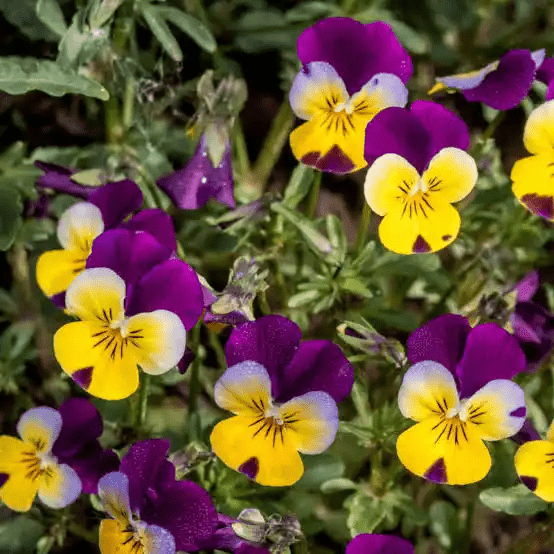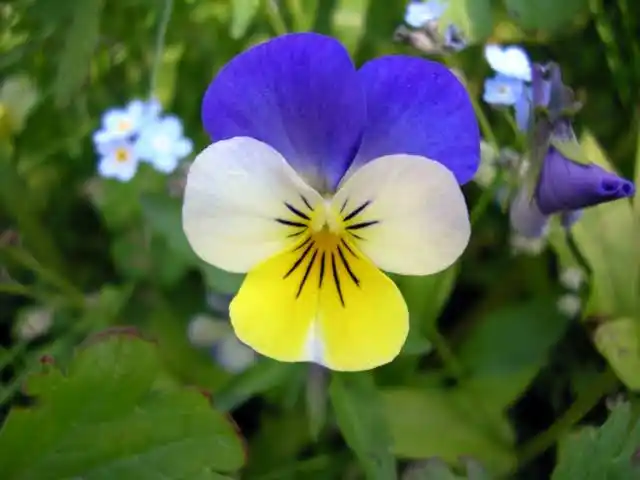Viola tricolor, commonly known as Heartsease or Wild Pansy, is a delightful and petite flowering plant that belongs to the Violaceae family. With its distinctive tricolored flowers and charming appearance, this species has found a place in gardens, meadows, and folklore throughout history.
The most striking feature of Viola tricolor is its small, pansy-like flowers that come in a captivating array of colors. Each flower typically exhibits three distinct colors, a face with a contrasting central blotch, surrounded by a background color and a delicate border.
The combination of purples, yellows, and whites creates a visually appealing display, earning it the name “Heartsease” for its heart-shaped petals.
Heartsease is a low-growing plant, usually reaching heights of 4 to 8 inches. The leaves are lobed and can be either toothed or smooth-edged, adding to the overall charm of the plant.
Viola tricolor blooms profusely in spring and early summer, attracting pollinators like bees and butterflies to its nectar-rich flowers.
Cultivating Viola tricolor is relatively straightforward, as it is adaptable to various soil types. These wild pansies thrive in well-draining soil and prefer partial shade, although they can tolerate full sun.
They are often found in meadows, open woodlands, and grassy areas. In gardens, Heartsease is well-suited for borders, rock gardens, or as a colorful addition to container plantings.
Beyond its aesthetic appeal, Viola tricolor has historical and cultural significance. In folklore, the plant has been associated with love, faithfulness, and remembrance.
The name “Heartsease” itself suggests a calming influence on the heart, and the plant has been used in traditional herbal remedies for various ailments.
Viola tricolor has also been immortalized in literature and art. Its charming appearance and symbolism have made it a subject of inspiration for poets, painters, and writers. The small, yet intricately designed flowers have become a metaphor for the delicate and fleeting nature of beauty.
When it comes to care, Heartsease is a relatively low-maintenance plant. Regular watering, especially during dry periods, can promote healthy growth and blooming.
Deadheading spent flowers encourages continuous flowering and helps maintain the plant’s appearance. These violets are generally resistant to pests and diseases, adding to their appeal for gardeners.
Viola tricolor, or Heartsease, stands as a testament to the beauty found in simplicity. Its tricolored blooms, heart-shaped petals, and cultural significance make it a cherished addition to gardens and natural landscapes.
Whether appreciated for its visual charm, historical symbolism, or medicinal uses, Heartsease continues to capture the hearts of nature enthusiasts and gardeners alike.
The Botanical Description of Viola tricolor (Heartsease)
1. Appearance: Viola tricolor, or Heartsease, is a small, delicate plant with vibrant tri-colored flowers—shades of purple, yellow, and white. It grows to about 6 to 8 inches in height.
2. Leaves: The plant features heart-shaped leaves arranged in a basal rosette, characterized by a distinctive serrated edge.
3. Flowers: Heartsease flowers are unique with a contrasting ‘face’ on the lower petal. This feature attracts pollinators like bees and butterflies.
4. Root System: Heartsease has a fibrous root system, providing stability in well-drained soils and enabling adaptation to various environments.
5. Blooming Season: Blooming from spring to early summer, Heartsease provides a burst of color, with continuous blooming under favorable conditions.
The Geographic Distribution of Viola tricolor (Heartsease)
1. Native Regions: Heartsease is native to Europe and parts of Asia, thriving in temperate climates.
2. Naturalization: Adaptable, it has naturalized in regions beyond its native habitat, including North America and Australia.
3. Preferred Habitats: Found in meadows, fields, and along woodland edges, Heartsease prefers open, sunny locations.
4. Global Presence: Cultivated globally as an ornamental plant, it’s a common sight in gardens worldwide.
The Chemical Composition of Viola tricolor (Heartsease)
1. Flavonoids: Rich in flavonoids, these compounds give Heartsease its vibrant pigmentation and offer antioxidant properties.
2. Alkaloids: Certain alkaloids contribute to the plant’s chemical composition, with potential diverse effects.
3. Saponins: Heartsease contains saponins, known for their foaming properties and potential contributions to defense mechanisms.
4. Salicylates: Some varieties contain salicylates, natural anti-inflammatory compounds linked to traditional medicinal uses.
5. Mucilage: The presence of mucilage, a gelatinous substance, adds to the plant’s traditional medicinal uses with potential demulcent properties.
Read Also: 7 Medicinal Health Benefits Of Ribes divaricatum (Straggly Gooseberry)
The Medicinal Health Benefits Of Viola tricolor (Heartsease)

1. Skin Health: Heartsease has been traditionally used for skin conditions. Its anti-inflammatory properties may assist in soothing irritations, eczema, and dermatitis.
2. Respiratory Support: The plant is believed to offer respiratory benefits. It may help alleviate symptoms of coughs, bronchitis, and other respiratory issues.
3. Anti-Inflammatory Effects: Heartsease contains compounds with potential anti-inflammatory effects, making it a consideration for managing inflammatory conditions.
4. Stress and Anxiety Relief: Traditionally, Heartsease has been associated with calming effects, potentially aiding in stress and anxiety reduction.
5. Cardiovascular Support: Some studies suggest that compounds in Heartsease may have cardiovascular benefits, supporting heart health.
The Methods of Usage to Achieve the Provided Health Benefits Of Viola tricolor (Heartsease)
1. Herbal Teas: Prepare herbal teas using dried Heartsease flowers or leaves. This is a common method to enjoy its potential health benefits.
2. Tinctures: Alcohol-based tinctures offer a concentrated form of Heartsease. These can be taken in small doses for various health purposes.
3. Topical Applications: Heartsease-infused oils or creams can be applied topically to address skin conditions or provide localized benefits.
4. Culinary Use: In some cultures, Heartsease is used in salads or as a garnish, providing a unique culinary experience while potentially offering health benefits.
5. Herbal Capsules: For a convenient option, Heartsease supplements in capsule form are available. These can be incorporated into a daily routine.
The Side Effects Of Using Viola tricolor Medicinal Plant
1. Allergic Reactions: Some individuals may be allergic to compounds in Heartsease, leading to skin rashes or other allergic reactions.
2. Interaction with Medications: If you are taking medications, consult with a healthcare professional, as Heartsease may interact with certain drugs.
3. Avoid During Pregnancy: Pregnant women should avoid using Heartsease, as its effects during pregnancy are not well-studied.
4. Not for Prolonged Use: Extended use of Heartsease may have unknown effects, and it’s advisable not to use it continuously without breaks.
5. Gastric Discomfort: In some cases, Heartsease may cause mild gastrointestinal discomfort. If this occurs, discontinue use.
Read Also: How to Farm and Care for Bigeye Tuna Fish (Thunnus obesus)
The Scientific Research and Studies of Viola tricolor (Heartsease)

1. Clinical Trials: Several clinical trials have explored the potential medicinal properties of Heartsease, focusing on its anti-inflammatory and skin-soothing effects.
2. Antioxidant Properties: Studies have indicated Heartsease’s rich antioxidant content, potentially contributing to its perceived health benefits.
3. Phytochemical Analysis: Scientific research involves the identification and analysis of various phytochemicals present in Heartsease, aiming to understand its therapeutic potential.
4. Traditional Use Validation: Some studies aim to validate Heartsease’s traditional uses through scientific methodologies, investigating its efficacy in addressing specific health concerns.
5. Comparative Analyses: Research often involves comparative analyses between Heartsease and other medicinal plants to assess its unique properties and potential advantages.
The Safety Precautions and Recommendations In Using Viola tricolor (Heartsease) Medicinal Plant
1. Consultation: Always consult with a healthcare professional before using Heartsease, especially if you have underlying health conditions or are taking medications.
2. Dosage Recommendations: Follow recommended dosage guidelines strictly. Excessive intake may lead to adverse effects.
3. Allergy Testing: Conduct allergy tests before extensive use, as some individuals may have allergic reactions to components in Heartsease.
4. Pregnancy and Lactation: Pregnant or nursing individuals should avoid using Heartsease due to insufficient research on its effects during these periods.
5. Adverse Reactions Monitoring: If you experience any adverse reactions while using Heartsease, discontinue use and seek medical advice promptly.
FAQs About Viola tricolor (Heartsease) Medicinal Plant
1. Is Heartsease safe for children?
While Heartsease is generally considered safe, it’s advisable to consult a pediatrician before administering it to children.
2. Can Heartsease interact with prescription medications?
Heartsease might interact with certain medications. Discuss its use with a healthcare professional if you’re on prescribed drugs.
3. How should Heartsease be stored?
Store Heartsease products in a cool, dry place away from direct sunlight to maintain their potency.
4. What is the typical recommended dosage for Heartsease?
Dosage varies based on form and individual factors. Follow the recommended dosage on the product or consult a herbalist or healthcare provider.
5. Are there any reported cases of Heartsease toxicity?
There are limited reports, but excessive consumption of Heartsease may lead to toxicity. Stick to recommended doses.
Read Also: Chinese Money Plant: Everything You Need to Know About The Pilea Peperomioides

